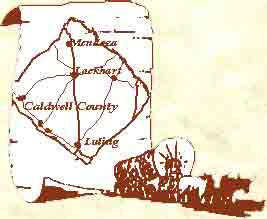
![]()

|
Martindale ~ ca 1858
Situated along the banks of the San
Marcos River, Martindale is located ten miles west of Lockhart at the
junction of State Highways 80 and 142. The town is named for George
and Nancy Martindale, early immigrants from Mississippi who donated
land for a townsite. Mrs. Martindale, a devout Baptist, helped
organize the first Baptist Church in 1858 and a private school in 1862.
A Christian Church was established in 1876, a Methodist Church in 1903
and a Catholic Church in 1905.
The first business, that of Robert
Martindale and a man called Quebe, was built below the present town
and was twice destroyed by flood. By 1881, though, there were
grocery and dry goods stores, a meat market, a blacksmith shop, a fruit
stand, and a cotton gin. The business section was originally located
several hundred yards nearer the river, but because of successive overflows
of the river, and the destruction of buildings, the town was built on
higher ground.
As the population grew, more and larger
public schools were built and by 1880 the town was outgrowing its third
school building. Today Martindale is consolidated with the Hays
County School District and the children attend classes in San Marcos.
During the 1890s, the large ranches
were fenced, the cattle industry declined, and farming became the leading
industry. Large cotton production in the area, and a seed hybridization
developed by W. W. Bagley of San Marcos and A. D. Mebane of Lockhart,
made the town of Martindale well known throughout Texas. At one
time, four large gins were in constant operation.
By 1900 the town had exceeded 600 in
population. With its prosperity in the early 1900s, an electric
system, water distribution, and telephone service were instituted.
A 2,700 sq. ft. building housed the Merchant-Planters Bank. In
1920 businesses included a picture show, bottling works, ice factory
and a garage. From the 1930s to the 1960s, Martindale continued
to live up to its name as “River Valley Garden Spot – Seed Bin of
Texas”.
Although most businesses have left
the little town, beautiful old homes still reside along its shady streets.
The town has become a mecca for artists, crafters, and antique dealers
and has even served as a background location for movie makers.
Source – Plum Creek
Almanac, Vol. 12, No. 2, Fall 1994, Plum Creek
Almanac, Vol. 17, No. 1, Spring 1999 and Caldwell County Kin:
The First 150 Years published by the Genealogical and Historical
Society of Caldwell County, November 2000.
The Plum Creek Almanac is a project
of The Genealogical and Historical Society of Caldwell County.
Copyright © 1963-2009  The Genealogical and Historical Society
of Caldwell County The Genealogical and Historical Society
of Caldwell County
Updated 09/03/2013 |

